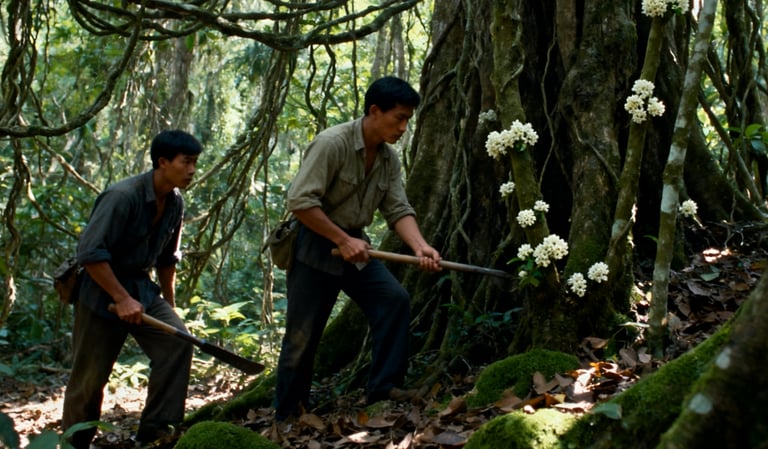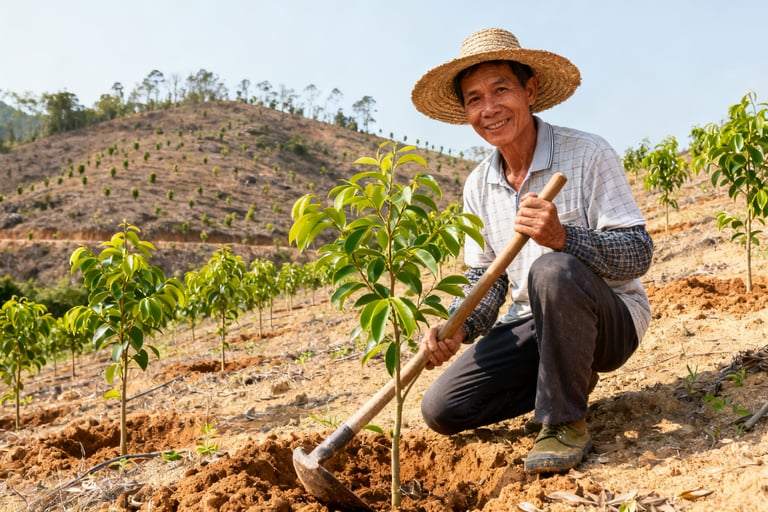The Legend of Dianbai's Agarwood Collectors
The Legend of Dianbai's Agarwood Collectors
11/19/20253 min read
In Dianbai, during the 1980s and 1990s, almost every village had a group of people whose fates were closely tied to a special fragrance. They were Dianbai's earliest, and ultimately last, generation of large-scale "agarwood collectors" who ventured deep into Hainan's mountains to harvest wild agarwood.
I. Braving Hainan: The Perilous Path of Agarwood Hunting
Back then, young local laborers had few options besides farming small plots of thin land. Deep in Hainan Island's dense, underdeveloped primeval rainforests, rumors spread of "wooden gold"—wild agarwood worth a fortune. Thus, groups of Dianbai youth in their twenties, driven by the desire to change their destinies, set off with primitive tools: machetes, saws, axes, and simple rations. They traveled by boat together, venturing into unfamiliar and dangerous mountain forests.
Their work was more like hunting than gathering. Their target was Aquilaria sinensis trees that had secreted resin and formed agarwood by chance, usually after being struck by lightning, broken by wind, or infested by insects. Such trees often grew on steep cliffs or remote valleys. Without GPS or rescue routes, they relied solely on experience passed down orally from elders and an almost instinctive intuition to search the vast sea of trees.
Every trip into the mountains was a life-or-death adventure. They faced not only steep terrain and slippery mountain paths but also venomous snakes, insects, sudden flash floods, and various unknown dangers. Finding a tree suspected of bearing agarwood required immense patience and luck; harvesting it demanded even greater courage and caution. Working on sheer cliffs, a single misstep meant certain death. When they finally obtained a piece of desirable agarwood, the real test began—they had to carry dozens of kilograms of harvest, trekking back through mountains for days to escape the wilderness.
This was a path where they gambled their lives for a better future. Those who succeeded could sell the agarwood in Dianbai or farther markets for a good price, improving the lives of their families. Those who failed might never leave the rainforest. The profits were enormous, but the risks were equally great.
II. From Prosperity to Decline: The Depletion of Wild Resources and the Iron Curtain of Regulations
The consequences of such near-predatory harvesting were obvious. Throughout the 1990s, especially around 1997, wild agarwood resources in Hainan's mountains dwindled at an alarming rate. Veteran collectors clearly felt that high-quality agarwood was becoming harder and harder to find—often, months of traveling yielded little. "Wooden gold" was truly becoming scarce.
At the same time, external rules began to change. In 1998, the international community took note of the endangered status of this precious tree species. Aquilaria sinensis was listed in the Convention on International Trade in Endangered Species of Wild Fauna and Flora (CITES), placing strict restrictions on its international trade. Shortly after, in 1999, it was designated a National Class II Protected Plant in China. This meant that the previous practice of freely entering mountain forests to harvest wild agarwood became illegal.
The fall of the regulatory iron curtain marked the end of an era. For Dianbai's agarwood collectors who relied on this trade for their livelihoods, it was undoubtedly a heavy blow. A way of life that had lasted for more than a decade suddenly came to an end, leaving the future shrouded in uncertainty.
III. Surviving Against All Odds: The Difficult Transition from "Loggers" to "Growers"
The old path was blocked, but people had to survive, and the flame of the industry could not be extinguished. Some foresighted Dianbai locals began to think about transformation. Since wild resources were depleted and protected, could they grow agarwood themselves?
The initial idea was simple: plant saplings and wait for them to form agarwood naturally. However, Aquilaria sinensis takes 20 to 30 years to form agarwood naturally—an excessively long cycle with too many uncertainties. For farmers supporting families, the risk was unbearable. Although some people in Guanzhu, Shalang, and other areas began to try planting agarwood trees on barren hills and converted old orchards, the promotion was slow. Most people adopted a wait-and-see attitude, making it difficult to expand the industry scale.
The real dilemma lay in technology: how to make artificially planted agarwood trees produce high-quality agarwood within an acceptable timeframe? Without breaking this bottleneck, the future of Dianbai agarwood remained bleak. The path forged by the older generation with courage and physical strength had reached its end. The next journey required something entirely different—technology, patience, and innovation.






Maoming ouddar Agarwood Co., Ltd
A timeless heritage, a captivating fragrance, a gift of beauty to share.
About Us
+86-13510743479
© 2025. All rights reserved.
Contact Us
Subscribe to our newsletter
Address
Dianbai District, Maoming City, Guangdong Province, China